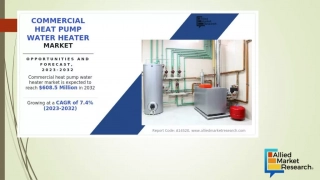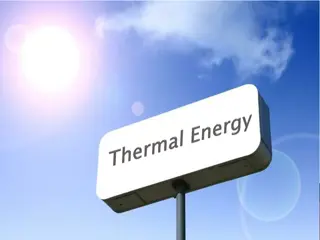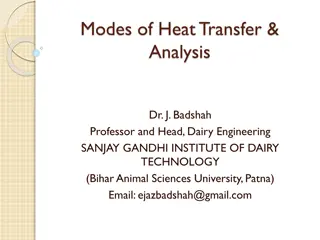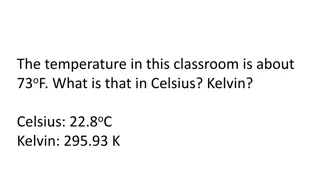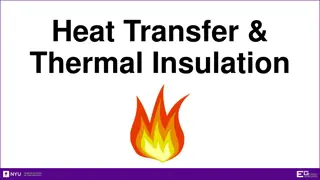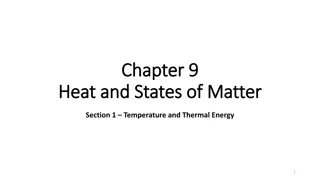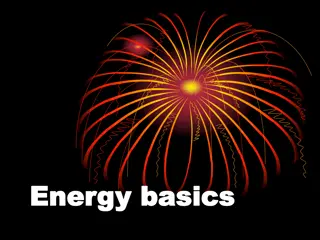Understanding Thermal Energy and Heat
Explore the concepts of thermal energy and heat through informative activities and discussions. Learn about the differences between thermal energy and heat, internal energy, bond energy, and more. Enhance your understanding of how energy is transferred and the importance of these concepts in everyday life.
Download Presentation

Please find below an Image/Link to download the presentation.
The content on the website is provided AS IS for your information and personal use only. It may not be sold, licensed, or shared on other websites without obtaining consent from the author. Download presentation by click this link. If you encounter any issues during the download, it is possible that the publisher has removed the file from their server.
E N D
Presentation Transcript
ACTIVITIES Watch the and, in pairs, answer the following questions: VIDEO What is thermal energy? ___________________________________________________ ___________________________________________________ ___________________________________________________ Thermal energy is the energy possessed by an object or system due to the movements of particles within the object or the system Which is the difference between thermal energy and heat? ____________________________________________________ ____________________________________________________ ____________________________________________________ Thermal energy is the energy possessed by an object or system connected to the movement of particles, while heat is the energy transferred from an object/system to another one.
ACTIVITIES With your partner, look at the gaps in the text below. Try to put the right word in each gap. When you have finished, listen to the text to check your answers. Between make fridge energy increase plus associated temperature potential end energy Internal energy is the total ____________associated with atoms and molecules (microscopic components) that a system possesses. It includes the ____________ energy between molecules as well as the kinetic energy of random translational, rotational, and vibrational molecular motion, but it does not include the bulk kinetic energy associated with the motion of the whole system. Internal energy is the thermal energy ___________bond energy. The former is the part of internal energy ___________ with the random motion of molecules, and it is related to temperature: an __________ in energy always corresponds to an increase in thermal energy and vice-versa. potential plus associated increase
between Bond energy, by contrast, is the potential energy that exists ___________ molecules. For this reason, even though internal energy is related to temperature, their relationship is limited: it s possible for a change in internal energy levels occur in the absence of any temperature variation. This happens, for example, during the formation of ice or the condensation of vapour. The _____________ of these systems remains constant until the ______ of the process. The everyday use of the word heat isn t often scientifically precise: in everyday terms, you heat a kettle of water to ________________ tea, you cool drinks in the _____________ , the Sun heats the Earth, that heat flows from the stove into a pot of soup, The correct way to define heat is: as energy in transfer between a system and its surroundings when they are at different temperatures. It also covers two systems or two parts of a body or system that are at different temperatures. temperature end make fridge
ACTIVITIES In pairs, answer the following questions: Are internal and thermal energy the same? Why? ___________________________________________________ ___________________________________________________ ___________________________________________________ Is an increase in internal energy always connected to an increase in temperature? Why? ___________________________________________________ ___________________________________________________ ___________________________________________________
As heat is energy in transfer by definition, a body never possesses heat! It has an internal energy, but not heat. Heat always flows spontaneously from a body at a higher temperature to a body at a lower temperature. This transfer of energy usually, but not always, is an increase in the temperature of the colder body and a decrease in the temperature of the hotter body.
a. As the red molecules in the hot object jiggle and vibrate, they hit some of the blue molecules in the colder object. This transfers energy from the hot molecules to the colder molecules, causing these molecules to vibrate faster. b. - d. Just like dominoes, heat passes along the chain until the energy is spread equally between all of the molecules.
What happens when heat goes into a substance? 1) The substance can experience a raise in temperature. The heat (the added energy) can be realized as an increase in the average kinetic energy of the molecules
The absorbed energy is not used to change the average kinetic energy of the molecules. The energy is used to change the bonding between the molecules. Changing the manner in which the molecules bond to one another can require an absorption of energy (heat) as in the case of melting, or require a release of energy (heat) as in the case of freezing
UNIT OF MEASURE OF HEAT joule=J Heat=energy Actually, scientists often use 1 calorie (1cal) defined as the amount of energy transfer necessary to raise the temperature of 1 g of water from 14.5 C to 15.5 C 1Cal=1kcal
HEAT CAPACITY AND SPECIFIC HEAT ACTIVITIES Watch the and, in pairs, try to summarise its content. video
Q t It depends on the substance and on the quantity of substance Heat added to or released by the system Q= C HEAT CAPACITY, the amount of energy required to raise the temperature of a particular sample of a substance by 1 C. Unit of measure: j/K j/ C t Difference between the final temperature of the system and its initial temperature: tf-ti
Q= t C If an object has a great heat capacity, the difference in temperature is less than the one occuring in a sample with a lower heat capacity (adding the same heat) The high heat capacity of water keeps its temperature within a relatively narrow range, causing nearby coastal areas to also have a narrow daily and seasonal temperature range. In contrast, areas with similar weather conditions that are farther from the coast tend to have a much wider range of seasonal and daily temperatures. To summarize, large bodies of water tend to moderate the temperature of nearby land due to the high heat capacity of water.
You have to spend a much larger quantity of energy in raising the temperature of a full swimming pool than you do to raise the temperature of a cup of water in the same t!
C m Heat capacity of the sample C= c SPECIFIC HEAT CAPACITY m It depends on the substance Mass of the object
C= Q= c C m t Q=C t C = mc Q=mc t
Q SPECIFIC HEAT CAPACITY, the amount of energy required to raise the temperature of 1 kg of a substance by 1 C. Unit of measure: j/kg K j/kg C c = m t 380 1830 Specific Heat of Brass Specific Heat of Beryllium 837 230 Specific Heat of Glass Specific Heat of Cadmium 2090 387 Specific Heat of Ice(-5 C) Specific Heat of Copper 860 322 Specific Heat of Marble Specific Heat of Germanium 1700 129 Specific Heat of Wood Specific Heat of Gold 2400 448 Specific Heat of Alcohol(ethyl) Specific Heat of Iron 140 128 Specific Heat of Mercury Specific Heat of Water(15 C) Specific Heat of Lead 4186 703 Specific Heat of Silicon 234 2010 Specific Heat of Silver Specific Heat of Steam(100 C) 830 Specific Heat of Aluminium 900 Specific Heat of Sand
Q t = mc Water is a liquid rather than gas (or water vapor) at room temperature because of the strong hydrogen bond between the molecules of water. (This strong bond causes water to resist molecular motion and remain a liquid at room temperature.) This means that it takes more energy or heat to increase water s temperature than it does for most other substances.
In pairs, answer the following questions: 1. A domestic hot water tank contains 200 kg of water at 20 C. How much energy must be supplied to heat this water to 70 C? _________________________________________________________ ________________________________________________________ 2. The specific heat capacity of steel is 420 J/kgK, what is the final temperature of 2.0 kg of steel when they absorb 200 J at 10 C? _________________________________________________________ _________________________________________________________ _________________________________________________________
There are 4 ways (a-d) to complete the sentences below. Which is correct? Explain why. 1. Heat spontaneously flows a) From a bigger body to a smaller body b) Between two bodies in thermal contact c) Between bodies in thermal equilibrium d) From a body at higher temperature to a body at a lower temperature 2. Heat capacity a) Doubles when you double the quantity of a substance b) Halves if the mass of the object doubles c) Is constant for any given object d) Is inverersely proportional to the object s mass 3. Specific heat a) Doubles when you double the quantity of a substance b) Halves if the mass of a substance doubles c) Is constant for a given object d) Is inversely proportional to an object s mass
How to convert calories in joules? Recreation of the Joule s experiment
W is converted in Q W=JQ Misured in J Misured in J Q=mwatc t W=n 2mgh 2nmgh 2nmgh=Jmwatc t J 4.186J/cal = = m c t wat
CALORIMETER A calorimeter is a device made up of an insulated material with a small mass, so to neglect its energy absorbtion It is well-insulated so that, ideally, no heat enters or leaves the calorimeter from the surroundings. For this reason, any heat liberated by the reaction or process being studied must be picked up by the calorimeter and other substances in the calorimeter. A thermometer is typically inserted in the calorimeter to measure the change in temperature that results from the reaction or physical process. A stirrer is employed to keep the contents of the calorimeter well-mixed and to ensure uniform heating.
1. What would be the final temperature of a mixture of 100 g of water at 90C and 600 g of water at 20 C in a calorimeter ? m1 = 100 g m2 = 600 g t1i= 90 C t2i= 20 C tf1=tf2=tf=? The first mass will ______ the heat Q1, while the second one will ___________ the heat Q2. Q1 is ____0, Q2 is _____0, so that the sum of them is _____ (the calorimeter is heat insulated) Q1 + Q2= ______ Using the formala Q=mc t, for each heat we obtain that: m1c(tf.t1i) + __________=_____ From which we calculate tf:
2)What would be the final temperature if a 2.0 kg piece of lead at 200C is inserted in a container with 10 kg of water at 50 C ? (for lead, c = 128 J/kg C) ___________________________________________________________ ___________________________________________________________ ___________________________________________________________ ___________________________________________________________ ___________________________________________________________ ___________________________________________________________
3. A piece of metal weighing 59.047 g was heated to 100.0 C and then put it into 100.0 mL of water (initially at 23.7 C). The metal and water were allowed to come to an equilibrium temperature, determined to be 27.8 C. Assuming no heat lost to the environment, calculate the specific heat of the metal. __________________________________________________________ __________________________________________________________ __________________________________________________________ __________________________________________________________ __________________________________________________________ __________________________________________________________ __________________________________________________________ __________________________________________________________
Working with your partner, read the text and circle the correct word in the pairs. Then listen to the text and check your answer http://publicdomainvectors.org/photos/boy_with_headphone5.png An introduction to Heat transfer Examples of heat tranfer phenomena are everywhere you are! Conduction heat transfer will be well known to/for you: you will have experienced it if you have ever burnt yourself on/in a hot pan by touching it, or if you have experienced different sensations when touching plastic handles and metal ones. If you can feel warm air away/around you from the heater in your room, and you are touching the heater, you are experiencing convection heat transfer. A current of warm air in contact to/with the hot heater will rise upward/downward in a bulk motion as cold air falls and replaces it..
The main source of energy in/for life on Earth is the Sun. Electromagnetic waves cover the long distance from/in the Sun and heat the Earth in a process called radiation heat transfer We refer to different types/effects of heat transfer processes as modes. When there is a temperature variation within a solid or fluid medium, we use the term conduction to refer to heat transfer that occurs across it. By contrast, the term convection refers to heat transfer that occurs between a surface and a muving fluid when the two are at different temperatures. The third mode of heat tranfer is thermal radiation: all surfaces of finite temperature (i.e. different from zero kelvin) emit energy in the form of/between electromagnetic waves. Hence, in the absence of an intervening medium, net heat transfer by radiation will occur between/among two surfaces at different temperatures.
CONDUCTION HEAT TRANSFER click Conduction occurs when a substance is heated, particles will gain more energy, and vibrate more. These molecules then bump into nearby particles and transfer some of their energy to them. This then continues and passes the energy from the hot end down to the colder end of the substance.
CONDUCTING HEAT IN A BAR difference in temperature between the two ends of the bar Q T Q A Cross-sectional area Q t Time interval Q 1/d Thicness of the bar, that is to say the distance heat must travel. T A FOURIER S LAW d Q k t = d Thermal conductivity
W Jm J J Qd k = = = 2 Kms Cms TA t Km s Thermal conductivity measures a material s ability to allow heat to pass through it via conduction. It is highly dependent on composition and structure. Generally speaking, dense materials such as metals and stone are good conductors of heat, while low density substances such as gas and porous insulation are poor conductors of heat.
Qd t = TAk t 1/k A high coefficient means heat moves very quickly-> thermal conductors; a low coefficient means heat moves very slowly - >thermal insulators For metals the thermal conductivity is quite high, and those metals which are the best electrical conductors are also the best thermal conductors. Heat and electrical transport both involve the free electrons in the metal.
Boards molecules vertical atmospheric difference external components caused lighter contact CONVECTION HEAT TRANSFER Convection heat tranfer occurs when there is a in temperature between a fluid in motion an a bounding surface. This fluid motion consists of a large number of moving collectively or as aggregates (i.e. in bulk motion). Convection heat transfer may be classified according to the nature of the fluid flow. Forced convection happens when the fluid flow is caused by means, such as a fan, a pump, or winds. For example, a fan can be used to provide forced convection air-cooling for hot electrical .. on a stack of circuit .. in a computer. difference molecules external atmospheric components boards
Free (or natural) convection happens when the fluid flow is induced by buoyancy forces, which arise from density differences .. by temperature variations in the fluid. An example of free convection is the heat transfer that occurs at home in radiators, during the winter. Air that comes into with the hot components of a radiator experiences an increase in temperature, and hence a reduction in density. As a consequence this air is than the surrounding air, and buoyancy forces induce a .. motion that replaces the ascending warm air with an inflow of cooler air. caused contact lighter vertical
RADIATION HEAT TRANSFER Radiation is energy emitted by matter at a finite temperature and tranferred by electromagnetic waves.
Emission happens as the result of changes in the electron configurations in the material s constituent atoms and molecules. While the transfer of energy by conduction or convection requires the presence of a material medium, radiation tranfer occurs most efficiently in a vacuum.
The rate at which this energy is released is proportional to the Kelvin temperature (T) raised to the fourth power. P T4 Stefan-Boltzmann s law 4 P= AT Absolute temperature (K) Power (in W) radiated from the surface of an object Area of the surface (m2) Emissivity: 0 1 It indicates how efficiently the surface emits compared to an ideal radiator or blackbody Stefan-Boltzmann constant =5.67 10-8 W/m2K4
Every object not only emits energy but also absorbs it if its hit by incident radiation ( ) 4 4 P A T T = net s sur Absolute temperature (K) of the surroundings Absolute temperature (K) of the body Net power (in W)
Fill the gap with the appropriate words or expressions Surface different place fluid 1) Convection heat transfer takes _______________ between a _________________ and a __________________ that are at ___________________ temperatures. Finite body temperature occur 2) Radiation heat transfer will _______________ if a _________________ has a __________________ ___________________ That medium temperature difference two points heat transfer 3)When a _______________ exist between _________________ of a medium, conduction __________________ will occur across ___________________
There are four ways (a-d) to complete the sentences below: working in pairs, choose the correct ones and justify your choices 1. Conduction heat transfer... a) Always occurs in the presence of a temperature difference b) Happens most efficiently via the motion and interactions of free electrons in metalic bonds c) Only occurs between two separate objects at different temperatures d) Only takes place between a body at a higher temperature and a body at a lower temperature 2. Convection heat transfer . a) Occurs between a fluid and a surface at different temperatures b) Always takes place in the presence of a temperature difference c) Only happens in gases d) Is the only mode of heat transfer that can occur when there is a temperature difference between two points in a liquid 3. Radiation heat trasfer a) Only occurs in a vacuum b) Occurs only in solids when the sorroundings are at a different temperature c) Takes place only in solids d) Is always occurring, because every medium has a temperature above zero kelvin
A box with a total surface area 1.50 m2and a side thickness of 2.0 cm is made of an insulating material. There is a 10.0 W electric heater inside the box, and it maintains the box s internal temperature at 20.0 C above its external temperature. Find the thermal conductivity k of the insulating material (Remember that P=Energy/time interval) ___________________________________________________________ ___________________________________________________________ ___________________________________________________________ ___________________________________________________________ ___________________________________________________________ ___________________________________________________________
The surface of the Sun has a temperature of about 5.800 K, its radius is 6.96 108m. Calculate the energy radiated by the Sun every second. Assume that the emissivity of the Sun is 0.965. ___________________________________________________________ ___________________________________________________________ ___________________________________________________________ ___________________________________________________________ ___________________________________________________________ ___________________________________________________________
Get into a group of three and, using internet, try to explain why, during the summer, it s better to wear white clothes and not dark ones How a thermos flask works ___________________________________________________________ ___________________________________________________________ ___________________________________________________________ ___________________________________________________________ ___________________________________________________________ ___________________________________________________________ ___________________________________________________________ ___________________________________________________________ ___________________________________________________________ ___________________________________________________________


